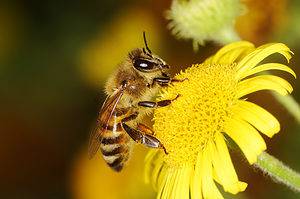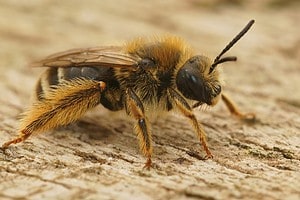Bees are some of the most common insects in the world. Over 20,000 species span every continent other than Antarctica. In North America alone, there are over 4,000 species of bees dwelling across the continent. Bees are characterized by two antennae attached to their head, six legs attached to their thorax, an abdomen, and two wings. They feed off of sugar and nutrient-rich flowers, distributing pollen between flowers during the process. While bees are known to sting, only female bees actually have stingers, making bee attacks much less frequent than believed. However, there are some species of bees known to be more aggressive than the rest. Here are the top five most aggressive bee species.

Africanized Honey Bee
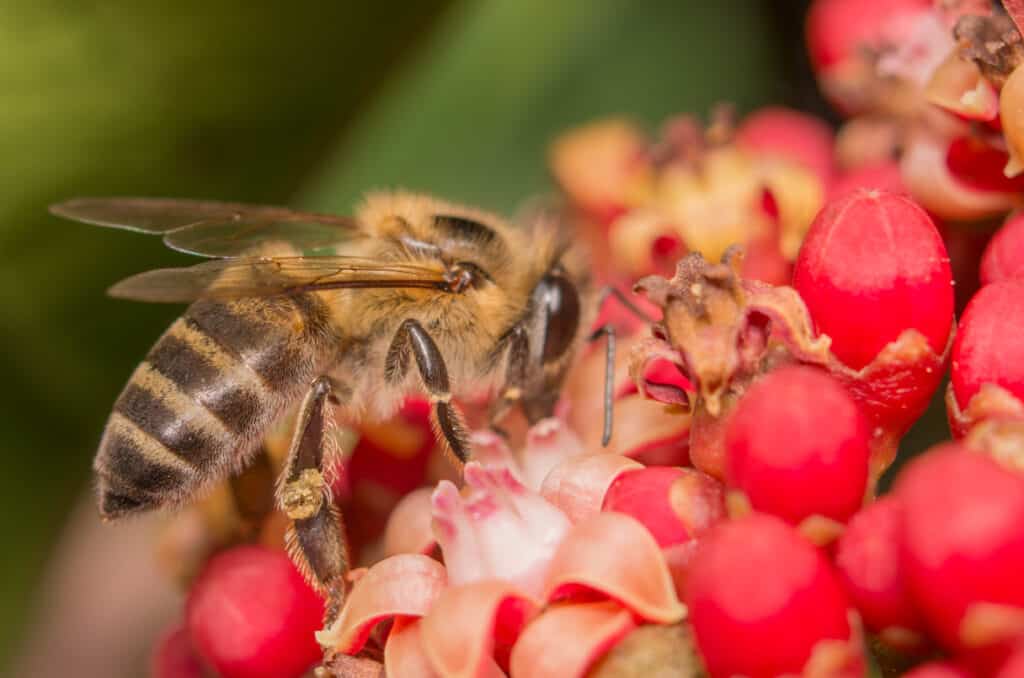
While they are identical in appearance, Africanized
honey bees
are much more aggressive than traditional honey bees.
©Philip Marsden/Shutterstock.com
Also known as the “killer bee,” the Africanized honey bee (Apis mellifera scutellata) lives primarily in sub-Saharan Africa. Recently, the bee has been introduced into the western hemisphere, including the United States. While Africanized honey bees are identical in appearance to traditional honey bees (Apis mellifera), they are much more aggressive in nature. Researchers believe that a possible reason for this distinction comes from the difference in which European and African beekeepers harvest honey. Honey harvesting in the latter is historically more violent.
Africanized honey bees become most violent when protecting their nest. They often swarm intruders within a much larger radius than other bee species. Due to their very small bodies, their deadly nature comes from their tendency to attack in numbers rather than the potency of their venom or the tenacity of any individual bee. These bees are dark brown and oval-shaped, with six legs and yellow stripes. They usually measure around half an inch (one and a half centimeters) in length.
Carpenter Bee

While only
female carpenter
bees sting, male carpenter bees (pictured) can be quite aggressive, particularly when defending their nest.
©Zety Akhzar/Shutterstock.com
Carpenter bees (Xylocopa) are found predominantly in the eastern United States. A few colonies are sprinkled throughout the western United States as well. These bees receive their name due to their tendency to burrow through wood in order to build nests. While female carpenter bees are the only ones with the capability to sting, male bees can often become aggressive when defending their nest. They often hover outside of the nest and swoop down at other insects and animals when a threat is sensed. While being stung by a female carpenter bee is incredibly rare, their stings are very painful and effective in deterring predators.
Carpenter bees are much larger than honey bees, measuring almost an inch (two and a half centimeters) long. They have a shiny black abdomen and a thorax covered in yellow and white hairs. Female bees have black heads, while male bees have black heads decorated with yellow or white markings.
Honey Bees
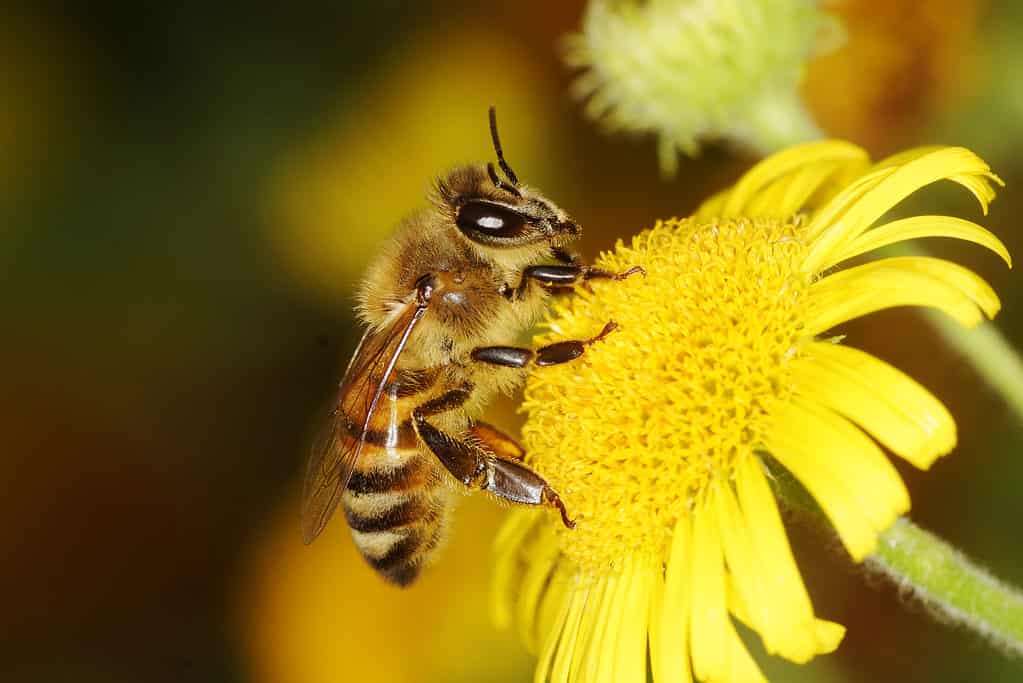
Aggression levels in honey bees can vary from colony to colony, but their defensive capabilities when in danger are impressive.
©Maciej Olszewski/Shutterstock.com
European honey bees (Apis mellifera) are now also referred to as domestic honey bees. This is because of their large presence in the United States. Honey bees are not commonly known as aggressive because of the variance in aggression among different colonies. While honey bees always respond to disturbances or threats, they are often few in number. In larger colonies, honey bees have swarms of defenses that accurately showcase the honey bees’ high level of aggression. They measure around an inch and a half (four centimeters) in length and vary in color. The insects also have five eyes on the tops of their heads.
European Wool Carder Bee
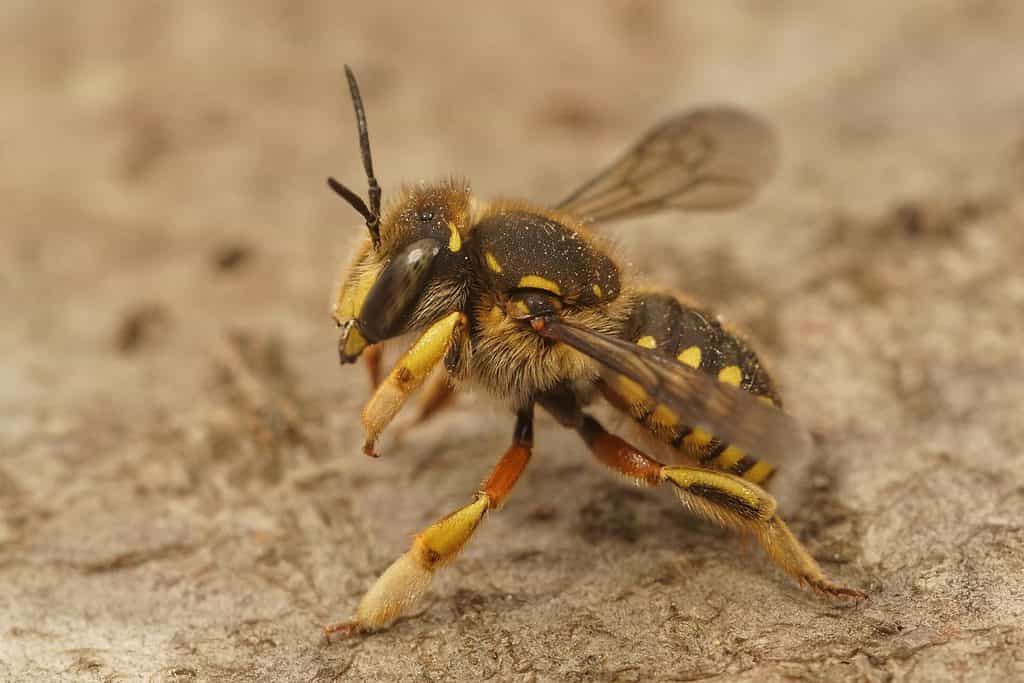
©Wirestock Creators/Shutterstock.com
The European wool carder bee (Anthidium manicatum) is one of the most widely distributed species of bees. It can be found on almost every continent, excluding Antarctica. The bees are known as relatively solitary when it comes to building and defending their nests, as each individual female bee is responsible for building her own home and laying eggs. However, male wool carder bees are known for their highly aggressive behavior when defending flower sites for females.
The male bees are so aggressive because they defend the sites in hopes of mating with a female, often fighting off other wood carder bees for a chance to reproduce. These bees are usually over half an inch long (one and a half centimeters), and are often mistaken for yellow jackets. They have bright yellow markings on their hairy bodies, and male wool carder bees have five spines on their abdomen in order to ward off predators. Female wool carder bees are typically larger with white hairs on the underside of their abdomen used for collecting pollen.
Stingless Bee

The stingless bee’s primary methods of defense are penetrating open orifices and nesting in attackers’ hair or fur.
©Pedro Turrini Neto/Shutterstock.com
Known as the “stingless bee,” the Trigona spinipes can most commonly be found in Brazil and other regions of South and Central America. While they cannot sting and their bite is relatively harmless, these bees are still known to be aggressive. When threatened, the stingless bees attack in massive swarms, buzzing loudly in order to disorient the predator. Their main method of defense is targeting and penetrating open orifices on the attacker’s body and nesting in its hair or fur.
Similar to the Africanized honey bee, the Trigona spinipes can sense the chemical trails of other bees and species in order to attack them for resources or territorial issues. These bees are amber-brown in color and covered from one end to another in fuzzy hairs. They measure about a fifth of an inch (half a centimeter) in length and have several sharp teeth rather than stingers.
Conclusion
While some species of bees are known to be highly aggressive, concern is growing for the insects due to a different issue. Recently, the bee population has drastically decreased throughout the United States. Possible causes of this endangerment include pesticides, deforestation, climate change, and harmful agricultural practices. This is concerning because bees are major contributors to a thriving environment through their effective pollination and honey production. Many initiatives have been started to protect the bees because while they can be aggressive, they help form the backbone of an ecosystem.
The photo featured at the top of this post is © Daniel Prudek/Shutterstock.com
Thank you for reading! Have some feedback for us? Contact the AZ Animals editorial team.





